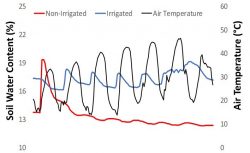Grapevines, sap flow and heatwaves

Heatwaves can have a significant impact on grapevines, scorching leaves and decreasing growth and yield. Grape growers deploy various strategies to protect their vines during extreme heat events which can include spraying canopies with “sunscreen”. Although these strategies have merit, they often involve investment in additional infrastructure or are laborious to employ.
Another strategy involves maintaining a healthy soil and ensuring soils are irrigated to field capacity at critical times during the growing season including prior to a heatwave event. This strategy has added benefits in that it uses existing irrigation infrastructure. Additionally, healthy soils also lead to healthy vines and increased crop quality and yield.
Recently, through the Wine Australia Riverina regional program the NSW Department of Primary Industries commissioned Edaphic Scientific to install a series of phyto-monitoring stations at vineyards near Griffith in the Riverina district of New South Wales. The primary aim of the phyto-monitoring stations was to monitor grapevine sap flow and growth during the heatwaves of the 2017/18 growing season. Soil volumetric water content and temperature were also monitored across the vineyards (Figure 1).
Analysis of the data is preliminary, however there appears to be evidence that maintaining soil moisture at saturation or field capacity prior to, and during, heatwaves assists grapevines. Data in Figure 2, for example, displays a 7-day period where daytime temperature regularly exceeded 40 °C and reached a maximum of 46.4 °C. Two of the grapevine varieties received irrigation and two did not receive any irrigation during the heatwave event. Sap flow in the irrigated vines was maintained at a high rate of over 2 litres per hour during the extreme heat. Additionally, the irrigated vines increased sap flow on the hottest days of the week. In contrast, sap flow in the non-irrigated vines declined to approximately half the rate of the irrigated vines. Significant leaf scorching and berry damaged was also observed on the non-irrigated vines compared with the irrigated vines (Figure 3).

Figure 2. Example data over a 7 day extreme heat event showing soil moisture and air temperature (top graph), and sap flow (bottom graph).
High rates of sap flow translate to high rates of transpiration which, in turn, provides a cooling effect for grapevines during extreme temperatures. Furthermore, sap flow is a general indicator of vine vitality. High rates of sap flow generally indicate that a vine has access to ample soil water resources; but it also indicates that stomata (the tiny pores on the leaves of plants) are open and absorbing carbon dioxide (CO2) for photosynthesis. Therefore, relatively high rates of sap flow suggest plant physiological processes are at an optimum and the plant is generally coping with any biotic or abiotic stress. The relatively higher rates of sap flow in the irrigated versus non-irrigated vine, suggests the irrigated vine was better able to cope with the heat stress event.
Although more research and analysis is required, preliminary results from the phyto-monitoring system over last summer’s heatwaves events suggest that maintaining high soil water content particularly in heat sensitive varieties can be a simple management strategy for growers to assist their crops through extreme weather events.
It is intended for the phyto-monitoring stations to continue monitoring grapevines and soil moisture through the 2018/19 growing season. The information these monitoring stations provide can be invaluable for growers to maintain, or even improve, production in the future where heatwaves are expected to be more common.
This article was first published in Profile, the newsletter of Soil Science Australia, issue 186, May, 2018.
Authors:
Michael Forster, Edaphic Scientific and The University of Queensland
Adrian Englefield, NSW Department of Primary Industries


